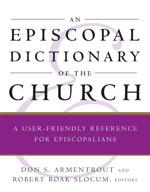Assimilation
I've never struggled to be a company man anywhere else but in the Episcopal Church. You can find me heartily joining in the rants against the Bush administration, educational disparities in this country, the War on Drugs, the prison system, healthcare. But when my agnostic friends would start in on the church, it got a lot more nuanced, sticky even. I still believe that Jesus said the highest most important things that have been said, and that the Church can be the revolving door of response to him.
So, in light of my history of bitching about the establishment in its many forms I should have expected the onslaught of institutional criticisms I've formed since arriving here. However, despite all I learned from Zinn, my own criticisms seem to threaten my one institutional loyalty. Let the schizophrenic internal dialogue begin.
I had to come here to work through this flawed institution, because without a keener eye I would be of no help to the Church. I have so far breezed through my experiences fingering all those things which "just gotta go" -- stodgy solemn chapel, secondary reading material which would seek to glorify Anglicanism over and above whatever its stated purpose, term-dropping without definition or conscious decisions to be inclusive. In the midst of all these, though, my more tender criticism were not far behind, and now I am faced with the prospect of being knee-deep in the rubble of a deconstruction without much of any idea how I'd like to put it back together again.
I refuse to see this experience as an upgrade in my club membership, but I also refuse to see it as a four year bitch session. I remember that my loyalty to Christ is loyalty to justice, love, and mercy. I want to know how to think more distinctly about institutions, their function and potential.
I can say with safety that I am no longer a Company Man. But I am here to learn more about this company. I will not merely assimilate, but commit to interact in a meaningful way, and not lodge my frustrations that they might harden my heart, but express them that I might release them.

Sarum Rite. Liturgy based on practices at the cathedral of Salisbury, England. Sarum is the Latin name for Salisbury. The Synod of Whitby (664) decided for Roman rather than Celtic liturgical usage, but British books still contained non-Roman elements. Secular cathedrals were strengthened after the Norman Conquest, and stronger centers influenced surrounding areas. The 1549 Prayer Book mentions uses of Salisbury, Hereford, Bangor, York, and Lincoln. These were not different rites but variations in words or actions or placement within the Roman rite. Consuetudinarium, or the book of customs, of Salisbury was earlier attributed to Osmud, Bishop of Sarum, 1078-1099, and founder of the cathedral at Old Sarum. The Salisbury use was therefore called Sarum Rite. It is now associated with Richard le Poore, bishop 1217-1228, who moved the see to Salisbury and initiated construction of a new cathedral. Later books (Ordinal, Customary, and "New" Ordinal) gave greater definition to the use. Because of the convenience of these books and the reputation of Salisbury as a model, this use spread over much of the British Isles. In March 1543 the Salisbury Breviary was imposed upon the whole Province of Canterbury. It is generally the use of Salisbury that is the source of medieval materials retained in the 1549 Book of Common Prayer.



1 Comments:
Zinnhead, you are an exceptionally good writer and I enjoy reading your Blog, girlfriend.
Have you assilated already? How is the transition from being a company man to not, and aren't there some heartstrings not yet unbound?
Remember that when you assimilate you make an ass out of "Im, [eh], late."
Post a Comment
<< Home